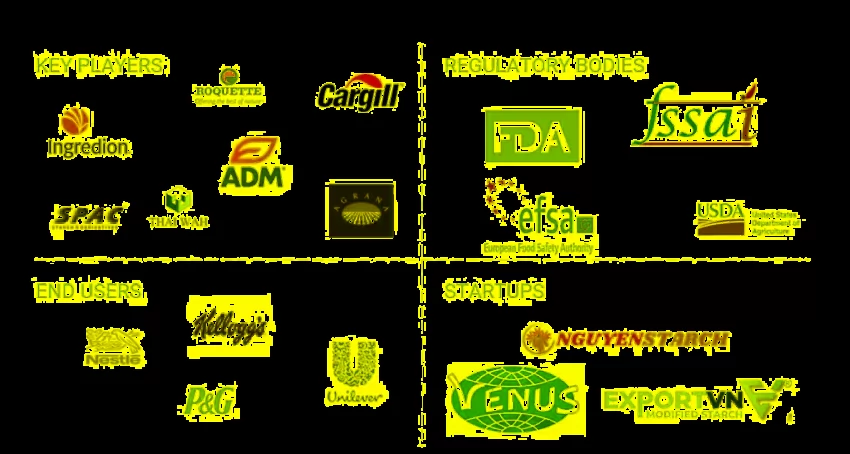According to MarketsandMarkets™, the cassava starch market is projected to grow from USD 2.52 billion in 2025 to USD 3.37 billion by 2030, at a CAGR of 6.0%. This growth is fueled by evolving eating habits, rising demand for processed and packaged foods, and the need for reliable, versatile ingredients in large-scale production.
Modified cassava starch blends seamlessly into formulations, ensuring products maintain their shape, texture, and shelf appeal. With dependable performance under heat and during storage, it remains a preferred solution for manufacturers aiming for stability without added complexity.
Chemically Modified Cassava Starch Leads the Market
Among modification types, chemically modified cassava starch accounts for the largest share. Its popularity stems from adaptability and resilience across multiple industries, including food, paper, textiles, pharmaceuticals, and adhesives.
Techniques like oxidation and cross-linking enhance stability, texture, and resistance to heat and acidity—critical factors for industrial-scale processing. Compared to physical and enzymatic alternatives, chemical modification is:
- Cost-effective and scalable
- Widely approved for food applications in major markets
- Reliable under extreme processing conditions
Make an Inquiry to Address your Specific Business Needs
While enzymatic and physical modifications are gaining ground in clean-label and natural product categories, chemical modification remains the industry leader thanks to its performance advantages and suitability for mass production.
Rising Demand for Liquid Modified Cassava Starch
The global cassava starch market is witnessing a notable shift toward the liquid form of modified cassava starch, even though dry starch currently dominates worldwide. The trend is driven by its practical benefits, including:
- Faster solubility and easier integration
- Reduced dust levels for safer processing
- Energy savings from eliminating additional processing steps
Liquid starch is particularly attractive for convenience foods, clean-label products, and instant formulations, given its cold-water solubility and high-temperature resistance. Beyond food, industries such as paper, textiles, and adhesives are also adopting liquid starch for its efficiency and process-readiness.
Although still a smaller segment, the liquid cassava starch market size is expanding rapidly and is expected to gain traction in both developed and emerging regions.
Asia Pacific: The Global Leader
Asia Pacific holds the largest share in the modified cassava starch market, backed by strong cassava cultivation and industrial demand. Countries like Thailand, Indonesia, Vietnam, and China dominate production and exports, especially of chemically modified starch.
Key growth drivers in the region include:
- Favorable agro-climatic conditions
- Strong industrial infrastructure
- Expanding domestic demand in food, paper, and textiles
- Government initiatives supporting cassava-based innovation
This foundation positions Asia Pacific as both the largest producer and consumer of modified cassava starch globally, while interest in the organic cassava starch market is also rising alongside clean-label demand.
Key Market Players
Leading companies shaping the market include:
- ADM (US)
- Cargill, Incorporated (US)
- Roquette (France)
- Ingredion (US)
- General Starch Limited (Thailand)
- SMS Corporation (Thailand)
- Asia Modified Starch Co., Ltd. (Thailand)
- Vietnam Tapioca Starch Solutions (Vietnam)
- Neo Nam Viet Co., Ltd. (Vietnam)
- Starch Asia (Thailand)
- Beneva (Thailand)
- SPAC Starch Products Private Limited (India)
- BS Starch Chemical (Thailand)
- Sonish Starch Technology (Thailand)
- Vedan Enterprise Corporation (Taiwan)
- Thai Wah (Thailand)
- Agrana (Austria)
The modified cassava starch market is set for steady growth through 2030, supported by its versatility, performance benefits, and rising global demand across food and industrial applications. With Asia Pacific leading the charge and liquid forms gaining momentum, this market is evolving to meet the needs of modern, efficiency-driven industries.
Frequently Asked Questions
- What is modified cassava starch?
Modified cassava starch is produced by processing natural cassava roots through chemical, physical, or enzymatic methods to improve texture, stability, and resistance to heat or acidity. It is widely used in food, paper, textiles, adhesives, and pharmaceuticals. - What factors are driving growth in the cassava starch market?
Growth is fueled by rising demand for processed and packaged foods, industrial applications, and the ingredient’s ability to perform consistently in large-scale production. - Which type of modification dominates the global cassava starch market?
Chemically modified cassava starch leads due to its adaptability, cost-effectiveness, and superior performance under extreme processing conditions. - What is the projected cassava starch market size?
According to MarketsandMarkets™, the modified cassava starch market will grow from USD 2.52 billion in 2025 to USD 3.37 billion by 2030, at a CAGR of 6.0%. - Why is demand for liquid modified cassava starch increasing?
Liquid starch offers advantages like faster solubility, reduced dust, and energy savings. It is especially popular in convenience foods, clean-label formulations, and industries like paper and adhesives. - Which region dominates production and demand?
Asia Pacific holds the largest share thanks to strong cassava cultivation and demand across food, textiles, and paper. Thailand, Vietnam, Indonesia, and China are leading producers and exporters. - Is there a growing organic cassava starch market?
Yes. With increasing consumer demand for clean-label and natural products, the organic cassava starch market is seeing steady growth, especially in premium and health-focused applications. - Who are the major players?
Key companies include ADM (US), Cargill (US), Roquette (France), Ingredion (US), General Starch Limited (Thailand), SMS Corporation (Thailand), Vietnam Tapioca Starch Solutions (Vietnam), and Agrana (Austria).

